| Subject |
Notes |
Images |
Fitz 7-Inch
Refractor
Erskine College |
The Erskine College Telescope. Seven inch refractor built in 1849 by Henry Fitz, one of the
first successful American telescope makers. This is the earliest known of the forty remaining
Fitz telescopes. Restored by ATS member Bob Ariail and donated to the South Carolina
State Museum in 1985. |
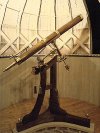 |
Clark 5-Inch
Refractor
Santa Clara U. |
Late 19th century five inch Clark refractor on display at the ATS 1994 Annual Meeting at
Santa Clara CA. Clark is recognized as America's "Artist in Optics". |
 |
Fauth 8-Inch
Refractor
Santa Clara U. |
Eight inch Fauth refractor located at the Santa Clara University's Ricard Observatory, being
examined by ATS founder Bart Fried during the 1994 ATS annual meeting. |
 |
Fauth Mount
Santa Clara U. |
Unrestored Fauth equatorial mount formerly in use at The Ricard Observatory at Santa
Clara University, now being restored by an ATS member to eventually mount a seven inch
Fitz refractor. |
 |
Clark 16-Inch
Refractor
Santa Clara U. |
Two shots of the equatorial mount of the 16-Inch Clark refractor at Ricard Observatory,
University of Santa Clara. |
 |
 |
Tulley
Objective |
Closeup of the objective lens of a 2.5 inch Tulley refractor, circa 1830, using crossed
polarizers to show stresses in the glass. |
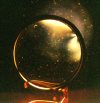 |
Tulley 2 5/8"
Refractor |
1830 era Tulley refractor,
2 5/8-inch aperture, 4 inch focal
length, Signed H. Tulley. (It is unclear whether it is by Henry Tulley of Bath of by Charles
Tulley of Islington.) - Closeup of the tailpiece and maker's signature. |
 |
 |
Clark 6-Inch
Refractor |
Outdoor shot of a nicely restored
tripod mounted 6-Inch Clark. - The same 6-Inch Clark mounted on its pier. |
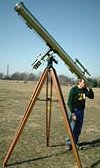 |
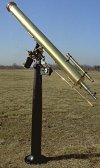 |
Secretan
4.1-Inch
Refractor |
Tailpiece
shots of the 19th century 4.1 inch f15 Secretan refractor. It is the same one that appears
mounted as the finder on the image of the 8-inch Fauth described above. |
 |
 |
Secretan
4.1-Inch
Refractor |
Lens shot
of the same Secretan. Note the lens spacers and the long screws protruding through
that secure the lens cell. On to restoration... |
 |
Flamsteed Telescope
Royal Observatory
Greenwich, England |
Interior view of The Great Star
Room or Octagon Room as it is now called at Flamsteed House next to the old Royal
Observatory at Greenwich, England. Little changed since built in 1675, this octagonal room has high windows for
observing and ladderlike supports for the long refractors of the day. From this room John Flamsteed, the first
Astronomer Royal, pursued his royal assignment: "...to apply himself with the utmost care and diligence to the rectifying
the tables of the motions of the heavens and the places of the fixed stars so as to find out the so much desired longitude
of places for the perfecting of the art of navigation." |
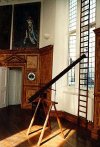 |
Flamsteed House
Royal Observatory
Greenwich, England |
Exterior of Flamsteed House. Built by Sir Christopher Wren in 1675 for John Flamsteed, the first Astronmer Royal at
the order of King Charles II of England. The residence is next to the old Royal Observatory at Greenwich, England. The
red "time ball" on the roof was added in 1833 as a visual signal for all the navigators on the nearby River Thames. A
transit in the observatory measured noon each day at the prime meridian. After setting chonometers, the ball was raised
at 12:55 PM and dropped precisely at 1:00 PM as a local time signal. In 1836 the Observatory began "distributing" the
time to the principal chronometer makers in London. John Henry Belville and later his daughter Ruth would set a large
pocket chronometer each Monday morning and set off down the hill to the City of London. The pocket chronometer
was affectionately referred to as "Arnold" after its maker John Arnold.
|
 |